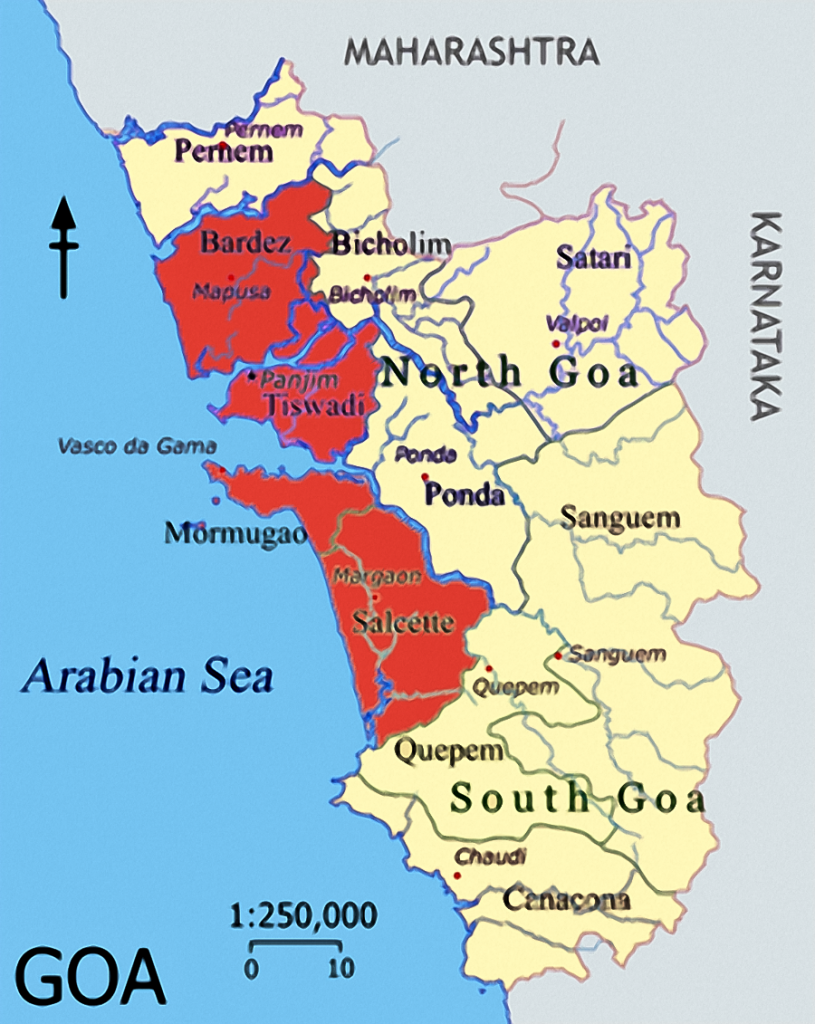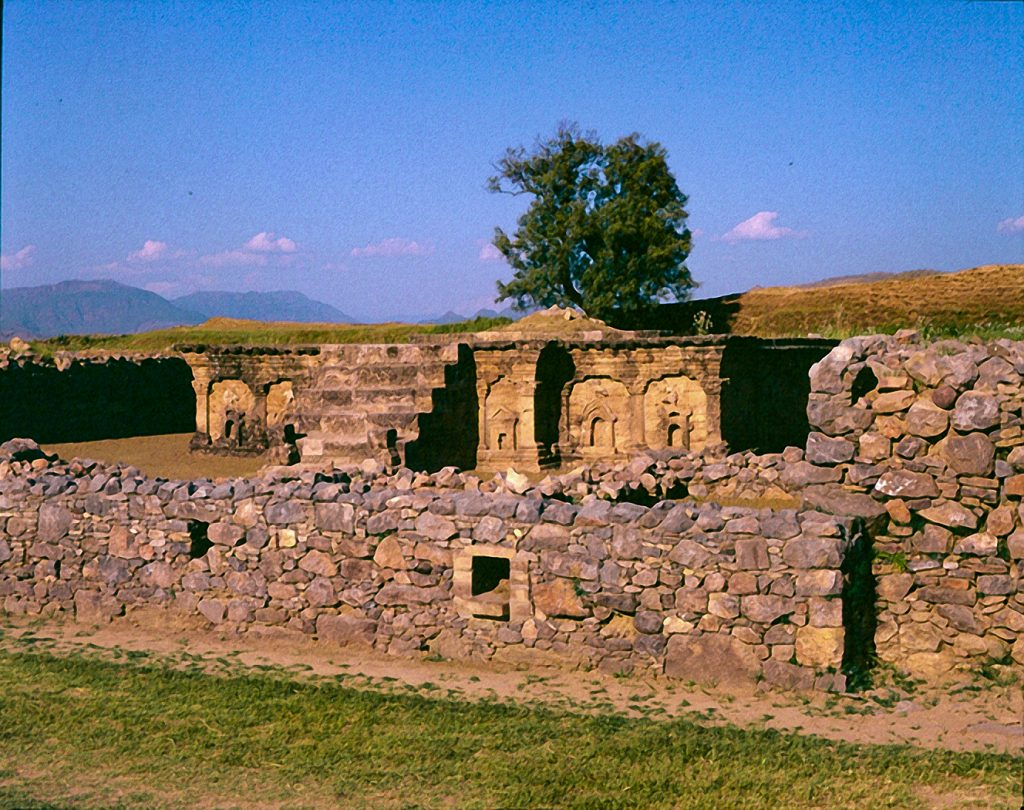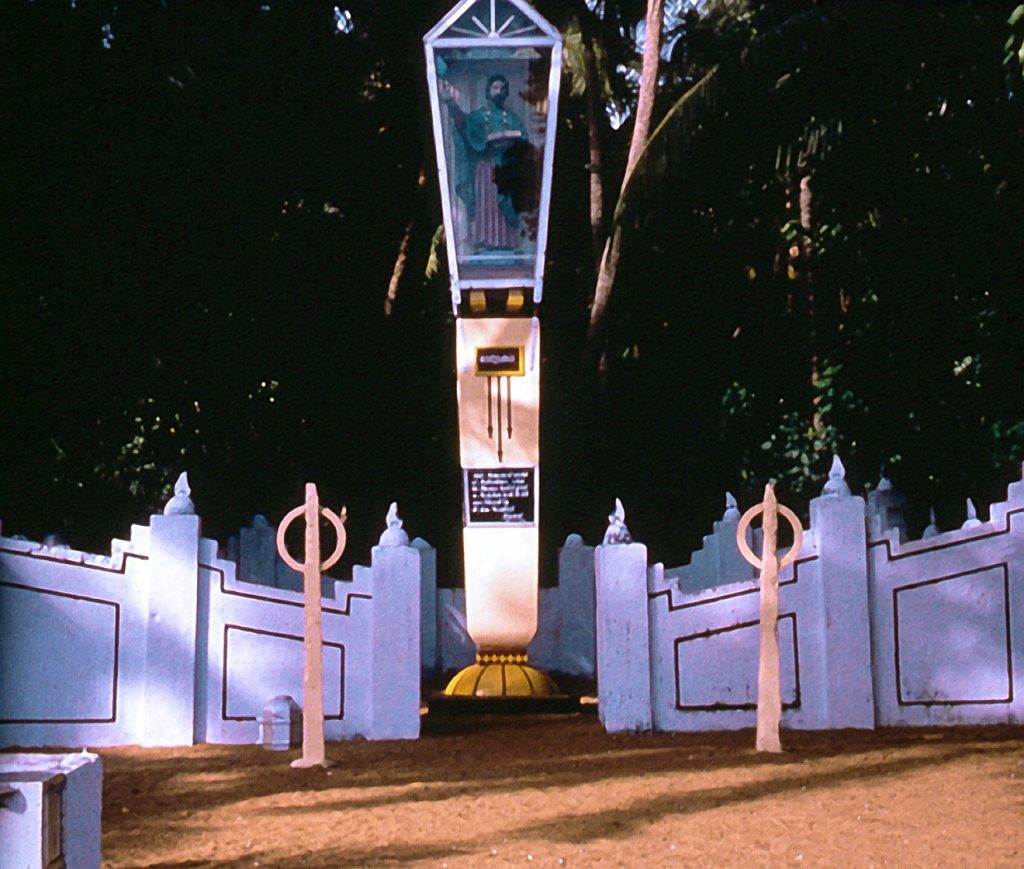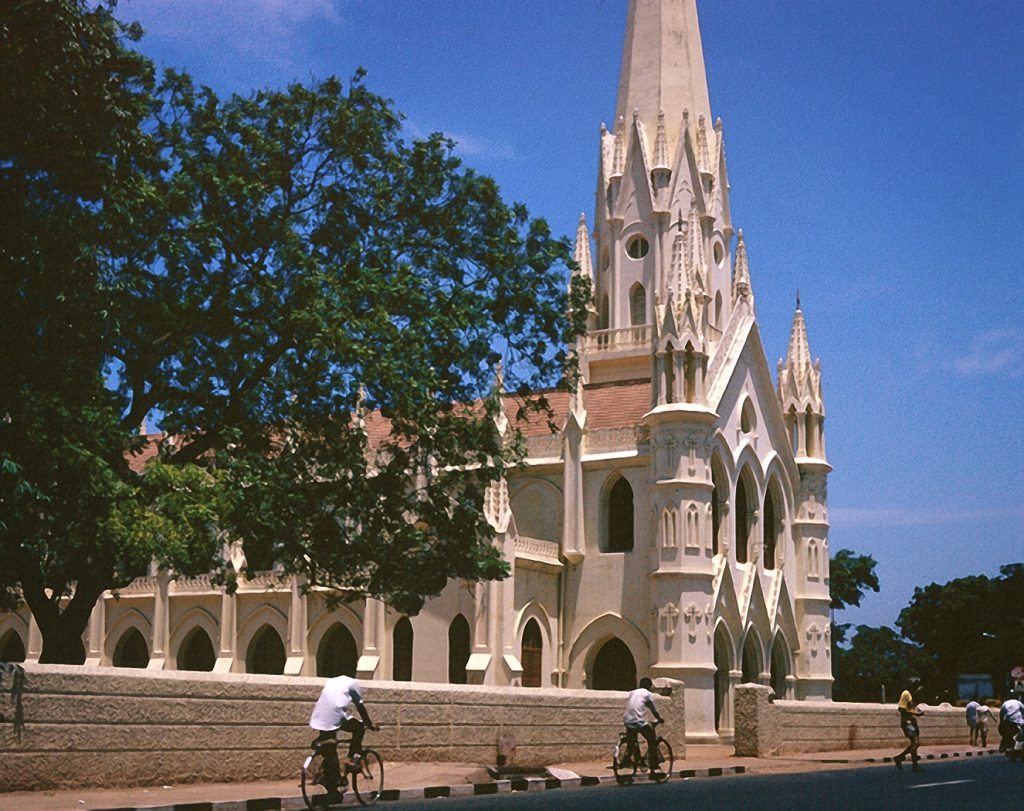With all its intolerance and its terrors, the Inquisition was set up atGoa (India) in the sixteenth century; and when it was resolved to subjugate the Syrian Church to papal jurisdiction, this relentless institution was used to overawe it, and to prevent the arrival of bishops from Babylon. The subjugation was consummated by the Synod of Diamper in 1599, and for nearly two generations Rome’styranny endured, until the splendid rebellion of the Assyrian Church at Coonen Cross.
See footnote 1
IN INDIA, the land of color and romance, the gospel was proclaimed

early as it had been in Italy. Christ had told His disciples that

is evidence enough that Thomas worked in Parthia. Libraries
THOMAS AND THE GOSPEL IN INDIA
The question of whether Thomas ever labored in India or not has been discussed by many authors, and immense research has been done in the hope of arriving at an irrefutable conclusion. It is well known that if the Church in the Wilderness ever suffered in any country, it certainly suffered in India. All are desirous of knowing who was the founder of that church. A. Mingana writes:
It is the constant tradition of the Eastern Church that the apostle Thomas evangelized India, and there is no historian, no poet, no breviary, no liturgy, and no writer of any kind who, having the opportunity of speaking of Thomas, does not associate his name with India.
See footnote

J. M. Neale testifies:
There is a constant tradition of the church, that the gospel was first preached in India by the apostle St. Thomas. Having evangelizedArabia the Happy, and the Island of
See footnote 6Zocotra , he arrived atCranganor, a town situated a little to the north of Cochin, andwhere the most powerful among the princes who ruled in Malabarthen resided. Having here wrought many miracles, and established a church, he journeyed southward to the city of Coulan. Here his labors were attended with equal success, and after traversing the peninsula he arrived at Meliapour, a town close to the more celebrated city of Madras. Sailing from this port he preached Christianity in China, and returning again to Meliapour, extended the knowledge of the faith so widely as to excite the envy and hatred of the Brahmins. Two of them watching anopportunity, stirred up the people against him; they fell on him and stoned him. One of the Brahmins remarking some signs of life in the holyapostle, pierced him with a lance, and thus completed his martyrdom.
M. L’Abbe Huc, the brilliant Jesuit traveler and writer, says:
The circumstance of St. Thomas having preached at all in India has been frequently called in question by writers deserving of
See footnote 7
attention; but we find it supported by so much evidence, that it seems difficult for an unprejudiced mind to refuse credit to a fact guaranteed by such excellent historical authorities. All the Greek, Latin, and Syriac monuments proclaim that St. Thomas was the apostle of the Indies, who carried the torch of faith into the remote regions where he suffered martyrdom. Some writers have affirmed that he prosecuted his apostolical labors as far even as China; and the mission and the martyrdom of Saint Thomas in the Indies have been alluded to in all the martyrologies, and in the ancient liturgies, which form themost pure and authentic source of Christian tradition.
W. F. Adeney, citing the origins of the Armenian, the Abyssinian, and the Georgian Churches, says:
The Syrian Church in India, which claims St. Thomas as its founder — all of
See footnote 8them independent churches in regions outside theRoman Empire — will claim our attention later on; because as they have remained in independent existence on to our own day we shall want to know something about the course of their history right down the centuries.
The testimony of J. D. D’Orsey is this:
Amidst the clouds which cover the traditions of the Christians of St. Thomas, the following account seems to possess the greatest amount of probability, and the nearest approach to truth. After having established Christianity in Arabia Felix, and in the island of Dioscorides (now called Socotra), the holy apostle landed at Cranganor, at that time the residence of the most powerful king on the Malabar Coast. We know, from the historians of the Christian people, from Josephus and from the Sacred Books themselves, in the account of the miracle of Pentecost that before the birth of Jesus Christ, there went forth from Judea a great number of its inhabitants, and that they were scattered throughout Egypt, Greece, and several countries of Asia. St. Thomas
See footnote 9learnt that one ofthese little colonies had settled in a country adjacent to Cranganor. Love for his nation inflamed his zeal; and faithful to the command of Jesus Christ who had enjoined His apostles to proclaim the faith to the Jews, before turning to the Gentiles, he repaired to the country which his compatriots had chosen for their asylum; he preached to them the gospel, converted them, and changed their synagogue into a Christian church. This was the cradle of Christianity in India.
ENTRANCE OF CHRISTIANITY INTO INDIA
In the days of Thomas the apostle, one authority states,
“One hundred twenty great ships sailed for India from Egypt every year.”
See footnote 10
As witnesses to the vast trade carded on between Rome and those eastern countries before and after Christ, large quantities of Roman coins have been found in south India lands. Theodor Mommsen evaluated the Roman coinage sent annually to India as being worth five hundred thousand pounds sterling
“Their sound went into all the earth, and their words unto the ends of the world,” the apostle Paul could say in his day of those who had spread the gospel. (Romans 10:18.)
Consider how many nations were represented at Jerusalem on the eventful Day of Pentecost, and the character of their representatives. “Devout men, out of every nation under heaven,” is the record. Who were they?
“Parthians and Medes, and Elamites, and the dwellers in Mesopotamia,… Cretes and Arabians.” (Acts 2:5, 9-11.)
The story of Pentecost spread as if on the wings of the wind when these visitors enthusiastically returned to their homes and hearths. Tradition claims that Thomas reached India soon after Pentecost
CHRISTIANITY’S EARLY GROWTH IN INDIA
Naturally, the Church of the East looking back to Thomas as its founder, placed no value on the claim that Peter was the “rock” upon which Christ would build His church and that He would give the “keys” to Peter only. The difference between the Church of India in dating its origins from the apostle Thomas and the Church of Rome in dating its origins from the apostle
When the Portuguese first opened the navigation of India, the
See footnote 17
Christians of St. Thomas had been seated for ages on the coast of Malabar…. The title of Mother of God was offensive to their ear; and they measured with scrupulous avarice the honors of the Virgin Mary, whom the superstition of the Latins had almost exalted to the rank of a goddess. When her image was first presented to the disciples of St. Thomas they indignantly exclaimed, “We are Christians, not idolaters!”
How much the world owes to the brave stand made by Christianity in India, man will never know until the judgment. For the first six hundred
For sixteen hundred years the St. Thomas Christians refused to put the church above the Bible. They found their starting point in the Sacred Scriptures, rather than in the catchphrase that the church was “instinct with heavenly life.” They refused to accept the teaching that the clergy only and not the laity were capable of interpreting the Bible. Accordingly, they clung to the Sacred Writings as the only channel through which the saving and transforming influence of the Holy Spirit could work. They refused to choose salvation through the sacraments rather than through the Scriptures. “The words that I speak unto you, they are
“Any attempt,” Mingana writes, “to speak of early Christianity in India as different from the East Syrian Church, is, in our judgment, bound to fail. Christianity in India constituted an integral part of the church that began to develop vigorously towards the end of the first century in the Tigris valley.”
See footnote 18
About this time three great revolutions of significance took place — one in the bosom of Christianity, one in the Parthian Empire, and the third in theRoman Empire. The first revolution occurred when the Church of the East definitely broke with the West by electing Papas of Seleucia as its independent supreme head (A.D. 285), thus recognizing the importance of a regular autonomous organization of its own. Why did this new catholicos ten years after his election make India into one of the grand ecclesiastical divisions of the world field and ordain David of Basra, famous for his learning, as the first supervising director of the new division?19 The answer is not far to seek. The
“In every church, and in many of the private houses, here are manuscripts in the Syriac language: and I have been successful in procuring some old and valuable copies of the Scriptures and other books, written indifferent ages and in different characters.”
See footnote 20
He wrote of another city in Travancore,
“In this
See footnote 21I have found a good many valuable manuscripts.” place
CHRISTIANITY IN INDIA DURING THE DARK AGES
Upon report from India on the condition of the Malabar Christians, the
For more than one hundred years fresh bands of believers kept arriving from Persia. The reign of Shapur II, who was ruling Persia after the adoption of Christianity in the Roman Empire by Constantine, lasted for more than sixty years. When Persia was at peace, primitive believers coming from the West were well treated; but in war it was different. The two empires being in conflict following the death of Constantine, it was natural that the Zoroastrians would be suspicious of all Christians and claim that they were spies in the pay of the Roman Empire. How India would be likely to become a haven of refuge to the persecuted is thus easily understood. That the existence of Christians in India appealed to the imagination of believers in Europe may be seen from the many references to the fact found in the writings of the second, third, and fourth centuries. The evangelical and simple spirit shown by the high reverence of these Christians for the Holy Scriptures characterized them as neither papal nor Jewish. Mingana writes: “The fifth century opens with an Indian Christianity which was in such a state of development that she is able to send her priests to be educated in the best schools of the East Syrian Church and to assist the doctors of that Church in their revision of the ancient Syriac translations of the Pauline Epistles.”(22) Thus the opening of the year A.D. 500 discloses communities of Assyrian Christians throughout India. Faithful in their evangelical missionary life, they assembled for worship on the Sabbath day
“This union of the Church of India with that of Mesopotamia and Persia is rendered more evident by another scholar of the school of Edessa, Mana, bishop of Riwardashir, who wrote in Persian (i.e., Pahlavi) religious discourses, canticles, and hymns, and translated from Greek into Syriac the works of Diodorus and Theodore of Mopsuestia and sent them all to India.”
See footnote 24
The Assyrian Christians were not only scholars, translators, and clergymen, but they were also travelers. Cosmas, who resided near Babylon, widely read for his explorations in the first half of the sixth century, sailed the Indian Seas so frequently that he has been called Indicopluestes (India traveler). Cosmas was personally in touch with the patriarch of the Assyrian Church. In his famous passages revealing how far-flung was the Church of the East, of which he was a member, he says that there was an infinite number of churches with their clergy and a vast number of Christian people among the Bactrians, Huns, Persians, Greeks, Elamites, and the rest of the Indians
“The above quotations from Cosmas prove not only the existence of numerous Christian communities among many central Asian people, in India, and in the surrounding districts, but also the subordination of all of them to the Nestorian patriarchate of Seleucia and Ctesiphon.”
See footnote 26
What Cosmas wrote about the island of Socotra in the Indian Ocean, lying directly in the path of sea travel from Egypt to southern India, is significant. He said that all the inhabitants were Assyrian Christians. Wha this successor in travels, the famous Italian voyager Marco Polo, who belonged to the papal church, wrote concerning Socotra in 1295 — long enough after Cosmas to see the headquarters of the church removed from Seleucia to Bagdad — is also revealing:
Their religion is Christianity, and they are duly
See footnote 27baptized, and are under the government, as well temporal as spiritual, of an archbishop, who is not in subjection to the pope of Rome, but to apartriarch who resides in the city of Baghdad, by whom he is appointed. Or sometimes he is elected by the people themselves, and their choice is confirmed.
Of the same place Nicolo de Conti, another renowned traveler, wrote about 1440:
“This island produces Socotrine aloes, is six hundred miles in circumference, and is for the most part inhabited by Nestorian Christians.”
See footnote 28
About the year 774 reinforcements arrived from the West. This event evidently raised the standing of the Malabar Christians in the eyes of the reigning king. He issued one of those copperplate charters, so familiar in the history of India, to Iravi Corttan, evidently the head of the Christian community. This recognized him as a sovereign merchant of the kingdom of

privileges granted them at the time on the copperplates politically raised the native church to a position of independence in their pagan surroundings; socially placed them next to the Brahmans

freedom in religious life. All this reveals the strength of the church on the Malabar Coast in the ninth century. Concerning their status seven centuries later, William W. Hunter writes: “The Portuguese found them firmly organized under their spiritual leaders, bishops, archdeacons, and priests, who acted as their representatives in dealing with the Indian princes. For long they had Christian
They said that they were from a city called Sarnau (in Siam) and had brought for sale silken
See footnote 40stuffs , andaloes wood , and benzoin, and musk. Which Christians said that in their country there were many lords also Christians, but they are subject to the great khan(of)Cathai (China). As to the dress of these Christians, they were clothed in akebec (jerkin) made with folds, and the sleeves were quilted with cotton. And on theirheads they wore a cap a palm and a half long, made of red cloth. These same men are as white as we are, and confess they are Christians…. We departed thence with the saidChristians, and went towards a city which is called Pego(in Burma), distant from Banghella (Bengal) about a thousand miles. On which voyage we passed a gulf (of Martaban) towards the south, and so arrived at the city of Pego.
Varthema was of the papal faith, and he recognized that the religion of the region of Pego was different. He says that the king “has with him more than a thousand Christians of the country which has been above mentioned to you, that is, Nestorians from Sarnau.”41 He and his traveling companions struck a bargain with the Christians that they should act as guides while they visited the islands of Sumatra, Java, Borneo, and Maluko. It is characteristic of this outstanding missionary church that its members were not content with having planted the seeds of their faith in Persia, India, and China, but that they also extended their work down the Malacca Strait over into Sumatra, Java, Borneo, and the Spice Islands. It is written that the
_________________________________________
FOOTNOTES / SOURCES
1 Rae, The Syrian Church in India, pp. 196, 197.2 Eusebius, Ecclesiastical History, b. 3, ch. 1, found in Nicene and Post-Nicene Fathers, 2d Series, vol. 1.
3. When the writer visited Miramon in the kingdom of Travancore in southern India, where the largest camp meeting in the world is annually held, the St. Thomas Christians enthusiastically pointed out the place where the apostle Thomas had built a church. “See,” said they, “that farm over there? That farm is located on the spot where he secured
4. Neale, A History of the Holy Eastern Church, vol. 1, General Introduction, p. 145.
5. Mingana, “Early Spread of Christianity,” Bulletin of John Ryland’sLibrary, vol. 10, pp. 447, 448.
6. Neale, A History of the Holy Eastern Church, vol. 1, General Introduction, p. 145.
7. Huc, Christianity in China, Tartary, and Thibet, vol. 1, pp. 17, 18.
8. Adeney, The Greek and Eastern Churches, p. 297.
9. D’Orsey, Portuguese Discoveries, Dependencies, and Missions in Asia and Africa, pp. 63, 64.
10. Mingana, “Early Spread of Christianity,” Bulletin of John Ryland’sLibrary, vol. 10, p. 90.
11. Ibid., vol. 10, p. 94
12. The Catholic Encyclopedia, art. “Thomas.”
13. Couling, The Luminous Religion, pp. 7-10.
14. Burkitt, Early Eastern Christianity, p. 34.
15. The Catholic Encyclopedia, art. “Calendar.”
16. Rae, The Syrian Church in India, pp 70-72.
17. Gibbon, Decline
18. Mingana, “Early Spread of Christianity,” Bulletin of John Ryland’sLibrary, vol. 10, p. 440.
19. Keay, A History of the Syrian Church in India, p. 17.
20. Buchanan, Christian Researches in Asia, pp. 126, 127.
21. Ibid., p. 140
22. Mingana, “Early Spread of Christianity,” Bulletin of John Ryland’sLibrary, vol. 10, p. 459
23. Mingana proves that as early as A.D. 225 there existed large bishoprics or conferences of the Church of the East stretching from Palestine
24. Mingana, “Early Spread of Christianity,” Bulletin of John Ryland’sLibrary, vol. 10, p. 460
25. Mingana, “Early Spread of Christianity,” Bulletin of John Ryland’sLibrary, vol. 10, p. 462.
26. Ibid., vol. 10, p. 462.
27. Komroff, The Travels of Marco Polo, p. 311.
28. Major, India in the Fifteenth Century, Travels of Nicolo Conti, p. 20.
29. Rae, The Syrian Church in India, p. 155.
30. Adeney, The Greek and Eastern Churches, pp. 520, 521.
31. Two of these plates were shown to the author by Mar Thomas (the word “Mar” is their title for
32. Hunter, The Indian Empire, p. 240.
33. Neale, A History of the Holy Eastern Church, vol. 1, General Introduction, p. 148.
34. Smith, The Oxford History of India, p. 300.
35. Yule, The Book of Ser Marco Polo, vol. 2, p. 427.
36. Mingana, “Early Spread of Christianity,” Bulletin of John Ryland’sLibrary, vol. 10, p. 487.
37. Major, India in the Fifteenth Century, Travels of Nicolo Conti, p. 7.
38. Ibid., p. 33.
39. Temple, The Itinerary of Ludovico di Varthema of Bologna From 1502to 1508, pp. 59, 60.
40. Ibid., pp. 79, 80.
41. Ibid., Preliminary Discourse, p.


I am genuinely delighted to glance at this website posts which consists of plenty of
helpful information, thanks for providing these data.